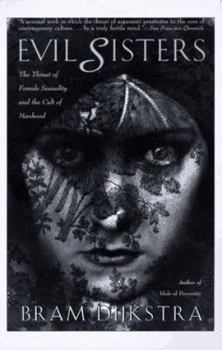Evil Sisters: The Threat of Female Sexuality in Twentieth-Century Culture
Select Format
Select Condition 
Book Overview
Explores the historical perception of woman as the seductress whose influence undermines the power of the white male. This description may be from another edition of this product.
Format:Paperback
Language:English
ISBN:0805055495
ISBN13:9780805055498
Release Date:January 1998
Publisher:Owl Publishing Company
Length:480 Pages
Weight:1.60 lbs.
Dimensions:1.3" x 6.2" x 9.2"
Customer Reviews
3 ratings
Shadow History
Published by Thriftbooks.com User , 17 years ago
This fascinating book explores some shadowy aspects of early 20th Century American cultural history...pop Nietzscheism and pop Darwinism combined to make a hideous blend of racism, eugenics, sexism, and very strange biological pseudosciences...this dark part of our intellectual heritage was ignored and forgotten after we saw that it led to Hitler and genocide...to learn about it is to fortify ourselves against its contemporary permutations.
A worthy follow-up to Idols of Perversity
Published by Thriftbooks.com User , 23 years ago
Because of his previous study/essays in Idols of Perversity, I grabbed this book almost immediately after it was published. Just like the other book, this one was very insightful about the sort of deep-seated cliches applied to women in the arts - the virgin/whore/child-bride/vamp, etc. After reading it, I sat down and had another look at my own writings and tried to eradicate all those crippling, limiting roles from my female characters. One only wishes that this sort of thoughtful re-examination of female archetypes would be applied to more novels and films especially.
deliberate digression
Published by Thriftbooks.com User , 24 years ago
Here is a book which can best be characterized as an inspired failure. That is no insult: academic literature is rife with works that either don't prove what they set out to prove and thus provoke indipensable rebuttals, or which set out to prove the obvious, and prove it to nobody's startlement or particular satisfaction, but, although their conclusions are unexciting, contrive to retain their currency by virtue of their usefulness as info-mines. Had Casaubon's _Key To All Mythologies_ been published, it might have been of the second type. (_Evil Sisters_ belongs to both categories.) Inspired academic failures are often nifty and in my opinion they are even necessary, since academic life depends on discourse and, in order to maintain discourse, someone always has to take the losing position. Henry Petroski writes books on the importance of failure in design; well, failure is no more expendable in discourse than in design; Dijkstra in _Evil Sisters_ proves as much, intentionally or not. Dijkstra's main contention, that racist and sexist books, pictures, and films led to the Nazification of Europe, is hooey. Sure, the books, films, and pictures existed, and sure the conquest of Europe by Nazi Germany took place, but that doesn't prove that the one LED TO the other. Events may demonstrably correlate statistically without correlating causally--as I learned in High School Social Studies. If racist pictures and literature abound, and if the Nazification of a continent occurs, isn't it at least as likely that both phenomena are due to some antecedent cause as that one phenomenon impels the other? Sure it is, as high school kids flunk Social Studies tests for failing to realize.Dijkstra's minor contention, that specific strains of antifeminism, anti-Semitism, and race-baiting were ubiquitous throughout the Western world around the turn of the century and up till World War II, is correct, but it's so indisputably correct that Dijkstra, never a fellow to let a blind alley go unexplored, experiences difficulty choosing among his sources. So much so that one is left wondering why Dijkstra should choose to pick on only certain people: why should he scold Fitzgerald and Hemingway for their unacceptable racial and sexual assumptions when London and Cather beckon as temptingly? Could it be because Fitzgerald and Hemingway are bigger literary game and consequently more fun to bag?Pretty much anything pop-cultural published around 1909 would be castigated as racist/sexist by today's standards; and, as per usual, the stereotypes perpetuated in the pulps found themselves echoed ("archetypally") in the pages of reputable writers. Dijkstra is spot-on in his observation that the basic difference between a stereotype and an archetype inheres in the reputability of the artist who invokes it. Hence, Al Jolson in "The Jazz Singer" has come to be an embarrassment while Willa Cather's blind, instinctually musical, perpet





